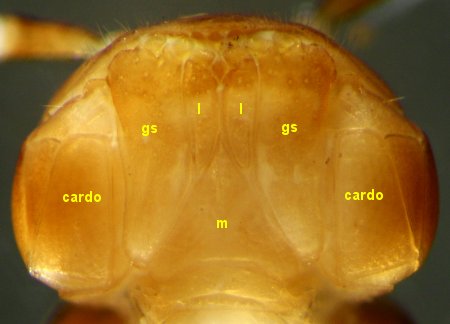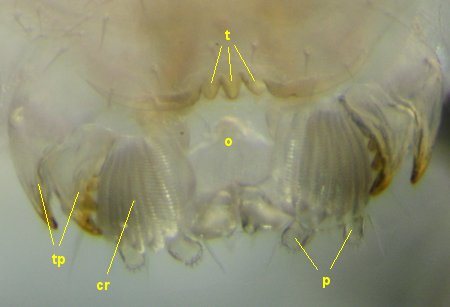Back to: colour
Forward to: antennae
Head
Polydesmida walk with their heads down (see image below). Even if they walked with their heads up they could not see where they were going, because Polydesmida have no eyes and are blind. They sense what is in front of them using their antennae.

Unidentified polydesmidan, Ecuador
Image © 2011 by Paul Bertner; used with permission
The angle at which the head is tilted downwards varies from group to group within Polydesmida. In many groups the front of the head is at roughly a 45 degree angle to the ground. In some groups the front of the head is nearly parallel to the ground, and the collum completely covers the head in dorsal view.
About half the head is a convex plate called the head capsule (image at right), carrying the antennae. The other half is made up of the mouthparts, which are joined to the capsule near the top of the head ('joint' in image). |
 |
Even though the head capsule is in one piece, parts of it are named. The top is the vertex. A shallow median groove called the vertigial sulcus runs from the back of the vertex to a point just above the antennae. The sulcus is not well-defined in some Polydesmida, and may be shorter than the one shown here. |
 |
Each antenna emerges from a well-defined socket (left antenna removed in specimen at right). The spacing between the sockets (s) varies from species to species, and is usually measured with reference to socket diameter (d). In the species shown (Somethus tasmani, Paradoxosomatidae, Tasmania), the spacing is about 1X a socket diameter, but the spacing can be greater than 2X in many Polydesmida. |
 |
A 'top' view of the head (image at right). Some Polydesmida specialists use the word occiput for the part of the head where I have placed the label 'vertex'. |
 |
A 'bottom' view of the head (image at right), showing the flat, rectangular plate which closes off the mouth cavity. This plate is called the gnathochilarium. Its fused-together parts are the mentum (m), the paired gnathochilarial stipetes (gs) and the paired lingual lobes (l). |
 |
At right is the open mouth of a cleared specimen of Lissodesmus perporosus (Dalodesmidae, Tasmania). The mouth opening (o) has the labrum above, with its three small teeth (t), and the gnathochilarium below, with two palps (p) at the tip of each gnathochilarial stipes. On either side of the opening are the complex tips of the gnathal lobes of the mandible, with tooth plates (tp) and comb rows (cr). |
 |
In this specimen the mouth is closed. Without the labels, see if you can recognise the antennal socket; the postantennal groove; the cardo, stipes and gnathal lobes of the mandible; and the palps on the gnathochilarium. Note also that there are many setae on the frons, but that the clypeus is almost bare. |
 |
Back to: colour
Forward to: antennae
